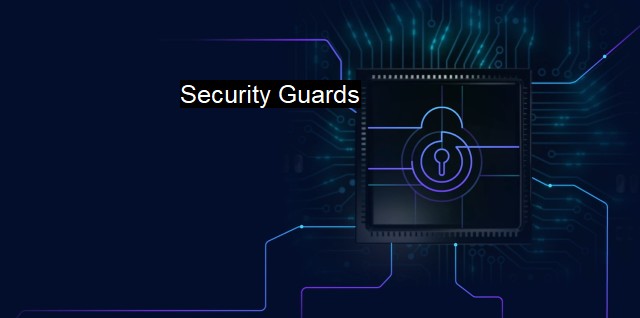What are Security Guards?
The Importance of Security Guards in Protecting Against Cyber Threats: From Traditional to Digital Roles
Security Guards, with refers to programs, systems, and measures designed to protect digital data and computing systems from cyber threats. They safeguard not only our systems but also software applications, networks, and critical infrastructure from digital attacks, unauthorized access, damage, or hacking attempts that may lead to loss or misuse of confidential, sensitive data.Cybersecurity focuses on preventing unauthorized digital access, use, disclosure, disruption, modification, or destruction. Activities range from implementing control measures to counteract threats to creating recovery plans to counter the effects of successful cyber-attacks. The Security Guards notion, thus, symbolizes the shield, or what acts as the first line of defense against cyber threats.
One of the principal responsibilities of these virtual guards is to systematically analyze a business's systems and processes to identify possible weak points that hackers can exploit. Following this, they work out strategies and security measures to enhance the falling defenses, subsequently reducing the vulnerability of the system.
Various types of Security Guards exist, each tailored for different types of threats or vulnerabilities. Firewalls monitor and control incoming and outgoing network traffic based on predetermined security rules. Antivirus software is designed to prevent, detect, and remove malware, ensuring that the system is safe to use. Intrusion Detection Systems (IDS) and Intrusion Prevention Systems (IPS) continuously monitor network activity, detecting suspicious behavior, enforcing security policies, and throwing alerts for any anomalies identified.
Encryption tools also act as digital security guards by converting information and data into a code to prevent unauthorized access. Email security solutions protect from dangerous elements like phishing, malware, and data loss, which are frequently spread through email communication. Identity and access management systems control who can access the system and when, and to what degree they can execute functions, thereby reducing improper access risks.
Among these defenses lies an aspect of behavioral analysis - observing system interactors' conduct to detect suspicious activities. So even if a user has the right credentials, unusual behavior could lead to them getting denied access. This way, they fulfill the role of digital bouncers or guards who ensure only proper use of the infrastructure.
Application Security Guard, another critical aspect, entails measures taken to enhance the security of an application often by finding, fixing, and enhancing the security of applications. It keeps pernicious hackers at bay from accessing, changing, or damaging valuable information and services the application delivers to end-users.
Security Guards in Cybersecurity & Antivirus is a constantly evolving arena that corresponds parallelly with advancements in cyber threats. As the internet and digital technology continue to get embedded in every facet of our lives, these security guard elements become even more critical.
Despite having sophisticated protection mechanisms and security guards, the human component poses a significant challenge. Often, cybersecurity incidents happen due to human error or negligence. It makes cybersecurity practices and awareness crucial for every individual and organization to understand and execute. So alongside the system's digital security guard, our collective effort becomes essential in creating and maintaining a safe and secure digital ecosystem.
In the grand scheme of cybersecurity, the concept behind ‘Security Guards’ forms an all-encompassing shield comprising cyber-protection strategies, systems, and efforts that help secure cyberspace from malicious intent. They are integral players dedicated to preserving the integrity, continuity, and safety of digital systems amidst a progressively hazardous digital frontier. They are symbolic warriors fighting on the virtual front-lines defending our digital territory from increasingly sophisticated cyber threats advancing each day.

Security Guards FAQs
What is the role of a security guard in cybersecurity?
Security guards play an important role in cybersecurity by monitoring and identifying potential security threats. They are responsible for ensuring the safety and security of an organization's assets, including computer systems, networks, and data. They also implement security measures such as antivirus software, firewalls, and intrusion detection systems.What skills are required to become a security guard in cybersecurity?
To become a security guard in cybersecurity, one must have knowledge of computer systems, networks, and cybersecurity threats. They should have a good understanding of antivirus software, firewalls, intrusion detection systems, and other security tools. Communication skills, problem-solving skills, and attention to detail are also essential.How does a security guard detect and respond to cybersecurity threats?
Security guards detect cybersecurity threats by monitoring network activity, log files, and other indicators of compromise. They also investigate suspicious behavior or anomalies on the network. When a threat is detected, they take immediate action to contain and isolate the threat, identify the source of the attack, and minimize any damage.What are the benefits of hiring a security guard for cybersecurity?
Hiring a security guard for cybersecurity can provide several benefits, such as improved threat detection and response times, better protection of data and computer systems, and enhanced overall security posture. Having a dedicated security guard can also help to reduce the risk of cyber attacks, prevent data breaches, and protect the reputation of the organization.| | A | | | B | | | C | | | D | | | E | | | F | | | G | | | H | | | I | | | J | | | K | | | L | | | M | |
| | N | | | O | | | P | | | Q | | | R | | | S | | | T | | | U | | | V | | | W | | | X | | | Y | | | Z | |
| | 1 | | | 2 | | | 3 | | | 4 | | | 7 | | | 8 | | |||||||